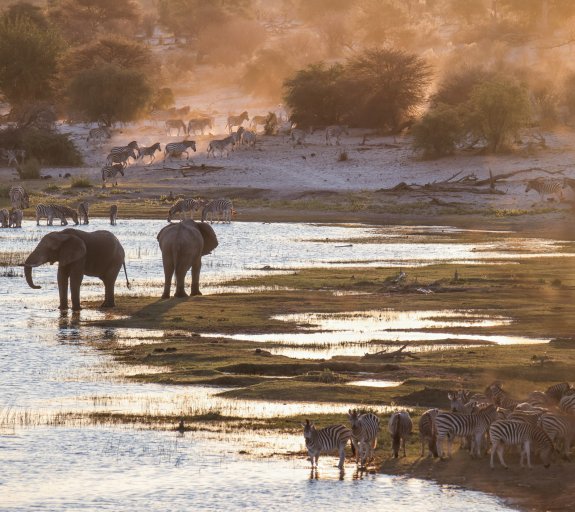
Why should investors care about biodiversity?
- 14 January 2025 (7 min read)
KEY POINTS
Biodiversity is the variability of all living organisms from all sources, spanning all ecosystems across land and sea. It encompasses the characteristics of living systems and includes everything from the diversity within a species to the diversity between species, and of the ecosystems in which they live.
Human life and a healthy planet depend entirely on the complex interactions between living organisms in nature – interactions that sustain crops, provide clean drinking water, decompose waste, help to regulate the climate and more.
Over approximately half the world’s GDP is reliant on nature and according to one report, these so-called ‘ecosystem services’ are estimated to be worth more than US$150trn annually2 .
Fundamentally, the more intact biodiversity is, the more resilient things like food and water supply, erosion and flood control or carbon storage can be.
However, biodiversity on earth is deteriorating at an alarming rate, faster than any time in human history – it has been referred to as the sixth mass extinction - and this can be predominantly traced back to human-induced changes3 . Today some one million species face extinction, according to the United Nations (UN)4 .

Source: Intergovernmental Science-Policy Platform on Biodiversity and Ecosystem Service. For illustrative purposes only
- R2xvYmFsIGFzc2Vzc21lbnQgcmVwb3J0IG9uIHRoZSBJbnRlcmdvdmVybm1lbnRhbCBTY2llbmNlLVBvbGljeSBQbGF0Zm9ybSBvbiBCaW9kaXZlcnNpdHkgYW5kIEVjb3N5c3RlbSBTZXJ2aWNlcywgSVBFQlMsIDIwMTkgLyA8YSBocmVmPSJodHRwczovL3d3dzMud2Vmb3J1bS5vcmcvZG9jcy9XRUZfTmV3X05hdHVyZV9FY29ub215X1JlcG9ydF8yMDIwLnBkZiI+V0VGIE5ldyBOYXR1cmUgRWNvbm9teSBSZXBvcnQgMjAyMDwvYT4gLyA8YSBocmVmPSJodHRwczovL3d3dy53ZWZvcnVtLm9yZy9wcmVzcy8yMDIwLzAxL2hhbGYtb2Ytd29ybGQtcy1nZHAtbW9kZXJhdGVseS1vci1oaWdobHktZGVwZW5kZW50LW9uLW5hdHVyZS1zYXlzLW5ldy1yZXBvcnQvIzp+OnRleHQ9VXBMaW5rLSxIYWxmJTIwb2YlMjBXb3JsZCUyN3MlMjBHRFAlMjBNb2RlcmF0ZWx5JTIwb3Isb24lMjBOYXR1cmUlMkMlMjBTYXlzJTIwTmV3JTIwUmVwb3J0JmFtcCI+O0hhbGYgb2YgV29ybGTigJlzIEdEUCBNb2RlcmF0ZWx5IG9yIEhpZ2hseSBEZXBlbmRlbnQgb24gTmF0dXJlLCBTYXlzIE5ldyBSZXBvcnQ8L2E+
- RW1lcmdlbmNlIG9mIGEgc2l4dGggbWFzcyBleHRpbmN0aW9uPywgSm9obiBDIEJyaWdncywgQmlvbG9naWNhbCBKb3VybmFsIG9mIHRoZSBMaW5uZWFuIFNvY2lldHksIE9jdG9iZXIgMjAxNw==
- PGEgaHJlZj0iaHR0cHM6Ly93d3cudW4ub3JnL3N1c3RhaW5hYmxlZGV2ZWxvcG1lbnQvYmxvZy8yMDE5LzA1L25hdHVyZS1kZWNsaW5lLXVucHJlY2VkZW50ZWQtcmVwb3J0LyM6fjp0ZXh0PVRoZSUyMFJlcG9ydCUyMGZpbmRzJTIwdGhhdCUyMGFyb3VuZCwyMCUyNSUyQyUyMG1vc3RseSUyMHNpbmNlJTIwMTkwMCI+VU4gUmVwb3J0OiBOYXR1cmXigJlzIERhbmdlcm91cyBEZWNsaW5lIOKAmFVucHJlY2VkZW50ZWTigJk7IFNwZWNpZXMgRXh0aW5jdGlvbiBSYXRlcyDigJhBY2NlbGVyYXRpbmfigJk8L2E+
The economic and investment implications
As highlighted, more than 50% of global GDP is dependent on biodiversity – and biodiversity loss impacts all industries. All parts of the economy have some degree of dependency on nature and generate impacts through their activities. However, for the agriculture, forestry and fishing, mining and manufacturing sectors, these dynamics are the most acute. Biodiversity loss also poses economic risks linked to major fluctuations in raw material costs and disruptions to operations and supply chains. The World Bank estimates that the collapse of three ecosystem services alone – wild pollination, timber supply and fish supply – would cost 2.3% of global GDP by 20305 .
- V29ybGQgQmFuaywgMjAyMQ==
New investment opportunities
The imperative for new sustainable production and consumption models brings with it a myriad of potential investment opportunities. One way our capital can have an impact is by investing in companies that are providing solutions to biodiversity loss – through products, services and technologies which better preserve and support ecosystems. This could be in areas such as precision or regenerative agriculture, plant-based foods, sustainable packaging and water treatment.
Investors can also play a part in protecting biodiversity through impact bonds6 – bonds where the proceeds are used to tackle environmental or social challenges. The finance raised through blue bonds (which raise finance for marine and ocean-based projects) or green bonds can be used to finance biodiversity-related projects. In addition, sustainability-linked bonds may offer complementary and more widespread potential investment opportunities as this market matures.
- PGEgaHJlZj0iaHR0cHM6Ly9jb3JlLmF4YS1pbS5jb20vZ2xvc3NhcnkiPkdsb3NzYXJ5PC9hPg==
A rapidly rising priority
Biodiversity loss and global warming are interconnected systemic risks – it is impossible to address one without reference to the other. Climate change is a primary driver of biodiversity loss and will likely overtake land use change to become the largest contributor beyond 20507 .
As the UN has asserted, biodiversity remains our strongest natural defence against climate change, which has “altered marine, terrestrial, and freshwater ecosystems around the world. It has caused the loss of local species, increased diseases, and driven mass mortality of plants and animals, resulting in the first climate-driven extinctions”8 .
Ultimately, biodiversity loss is fast becoming an increasingly important part of the global agenda as public policy and the evolving regulatory landscape have upped the pressure on governments and companies to do more. For example, at the UN biodiversity conference COP15 in December 2022, countries reached a landmark agreement, adopting the Post-2020 Global Biodiversity Framework (GBF) – biodiversity’s equivalent to the Paris Agreement on climate change.
The GBF, which is also referred to as the Kunming-Montreal Agreement, sets out clear goals and a roadmap to halt and reverse biodiversity loss by 2030 to achieve a shared vision for “living in harmony with nature by 2050”. In addition, the Taskforce on Nature-related Financial Disclosures (TNFD) released its framework in 2023.
Both initiatives seek to provide consistent, comparable, and decision-useful information for businesses and financial markets. Helpfully for investors, the TNFD approach has mirrored that of the Task Force on Climate-Related Financial Disclosures (TCFD) by aiming to develop a framework for companies to disclose and manage nature-related risks and opportunities in a manner similar to the TCFD's framework for climate-related financial disclosures.
Today there is an ever-growing range of innovative technologies, processes and approaches being developed across sectors, that help companies lessen their impact on the environment and particularly on biodiversity.
For investors, it is becoming increasingly important to consider how biodiversity loss might impact long-term portfolio sustainability – namely in the form of business and market disruptions, reputational and regulatory risks, as well as the potential returns from investing in this multi-decade investment opportunity.
- R2xvYmFsIEJpb2RpdmVyc2l0eSBPdXRsb29rIDUsIENvbnZlbnRpb24gb24gQmlvbG9naWNhbCBEaXZlcnNpdHksIDIwMjA=
- PGEgaHJlZj0iaHR0cHM6Ly93d3cudW4ub3JnL2VuL2NsaW1hdGVjaGFuZ2Uvc2NpZW5jZS9jbGltYXRlLWlzc3Vlcy9iaW9kaXZlcnNpdHkiPkJpb2RpdmVyc2l0eSAtIG91ciBzdHJvbmdlc3QgbmF0dXJhbCBkZWZlbnNlIGFnYWluc3QgY2xpbWF0ZSBjaGFuZ2U8L2E+
How to invest
Even once investors have decided to integrate biodiversity into their investment portfolio, the key question becomes how to do it and in which asset class.
We see three main approaches to building a dedicated biodiversity investment strategy
- Low biodiversity footprint approaches: Investing in companies that have a limited, low or below-average impact on biodiversity through their products and/or operations
- Biodiversity solutions: Investing in companies providing solutions via their products and services that support the transition to a lower biodiversity-impact society. This is our preferred approach currently when considering listed equity investments
- Nature capital solutions which target habitat protection and restoration in private markets by investing in projects and companies protecting, restoring and sustainably managing natural capital
In addition to these very targeted approaches it is important to remember investors can already take steps to consider biodiversity across their investments via stewardship, exclusions and reporting. This is our preferred approach in fixed income, where in addition to engaging exclusion and reporting investors can consider an allocation to green bonds and in time as issuance increases to blue bonds.
Therefore, integrating biodiversity considerations into investment activities, including prioritising biodiversity-friendly investments, may be key to managing risks and contributing to positive social and environmental outcomes.
Disclaimer
The information on this website is intended for investors domiciled in Switzerland.
AXA Investment Managers Switzerland Ltd (AXA IM) is not liable for unauthorised use of the website.
This website is for advertising and informational purpose only. The published information and expression of opinions are provided for personal use only. The information, data, figures, opinions, statements, analyses, forecasts, simulations, concepts and other data provided by AXA IM in this document are based on our knowledge and experience at the time of preparation and are subject to change without notice.
AXA IM excludes any warranty (explicit or implicit) for the accuracy, completeness and up-to-dateness of the published information and expressions of opinion. In particular, AXA IM is not obliged to remove information that is no longer up to date or to expressly mark it a such. To the extent that the data contained in this document originates from third parties, AXA IM is not responsible for the accuracy, completeness, up-to-dateness and appropriateness of such data, even if only such data is used that is deemed to be reliable.
The information on the website of AXA IM does not constitute a decision aid for economic, legal, tax or other advisory questions, nor may investment or other decisions be made solely on the basis of this information. Before any investment decision is made, detailed advice should be obtained that is geared to the client's situation.
Past performance or returns are neither a guarantee nor an indicator of the future performance or investment returns. The value and return on an investment is not guaranteed. It can rise and fall and investors may even incur a total loss.
AXA Investment Managers Switzerland Ltd.


